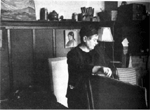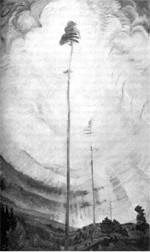Susan Crean's The Laughing One: A Journey to Emily Carr is another attempt to determine what and how Carr "means" in Canadian postmodern culture, even as it also attempts to contextualize Carr within her own period. As such, Crean's book is a contribution to a growing body of critical work that is proliferating around Carr and that marks a resurgence of interest in her work and person. The sharpening critical divide over the positioning of Emily Carr as both artist and writer within English Canadian culture suggests part of the reason for this interest (the other part being the fascination with Carr's unusual character), but also suggests the kind of ambivalences that Carr and her creative output¨much like the Group of Seven and their work¨contain.
Carr's rapidly growing popularity since the late 1960s in English Canadian culture, the manner in which she is configured in various biographical and critical studies, and the questions raised with respect to her cultural status signal as much as encapsulate these ambivalences: Is she modern or postmodern? Colonial or postcolonial? Regional or national? Is she feminist or is she perpetuating the patriarchal conventions of her time? Does she treat Native culture sensitively, or has she appropriated that culture for her own artistic purposes? Such questions¨and the radically different responses¨indicate how much Carr remains an enigmatic, fascinating, and ambiguous figure; more broadly, the questions demonstrate to what extent she straddles (at least) two worlds because she inhabited a nation that was breaking from (and perhaps continues to break from, culturally speaking) its imperial antecedents, and that was striving for independence, even as it was informed by those imperial antecedents.
 Emily Carr in her studio.
Emily Carr in her studio.
Crean's title is suggestive: yet, this is not just "a" journey to Carr, this is Crean's journey, and an often entertainingly digressive one it is. In journalistic fashion, she traverses a temporal and geographical landscape that spans, respectively, more than one hundred years and two continents (North America and Europe) to engage with a wide range of persons. Divided into five sections, each of which revolves around what Crean considers to be a pivotal moment in Carr's life, the book also contains a series of digressions from the main subject to consider those who occupied Carr's attention, such as Frances Hodgkins, Marius Barbeau, Bess Harris, Ira Dilworth, and, more unconventionally, those who did not, but who may have played equally significant roles, such as, perhaps most famously, Georgia O'Keefe and also Pauline Johnson. Crean then loops back to the present to consider related contemporary political (national, native) and environmental issues, and to entertain the opinions of those who may have inherited some narrative or tale about Carr.
Crean proceeds to intersect these characters and concerns with the figure of Carr herself. "Reflection," as Crean employs the term, is not just the act of musing upon this fascinating artist, but also the manner in which she is seen and refracted by both her contemporaries and ours: as Crean asserts, "there is no one Emily Carr." Perhaps this explains why she believes Carr to be best scrutinized by a postmodern audience, and why she intermingles fictionalized excerpts with well-documented facts about her life. This may also be why Crean begins her exploration with an entry from the fictional journal of Mayo Paddon¨who eventually proposed marriage to Carr¨in which he muses upon Carr and her presence aboard the Willapa. This is an odd if not inappropriate beginning to the book, especially when one considers, first, how much Carr detested being shaped and filtered by male perception rather than being accepted on her own terms, and, second, that, as Crean herself writes, "Paddon was less an actor in the drama than an embellishment in a story already in progress."
 Emily Carr, "Scorned as Timber, Beloved of the Sky", 1935
Emily Carr, "Scorned as Timber, Beloved of the Sky", 1935
Yet the reader may be prepared to read as much about Crean as they will about Carr. She confesses as much in the "introduction" (a most autobiographical one, indeed), where she observes that "like me, Emily's painting imposes itself on its surroundings." Such a declaration, I think, may be part of Crean's intellectual project: it is a nod to the postmodern truisms that reality is elusive because all is filtered through one's subjective perceptions, that each writer and critic has an "angle" or interest in their own work ("it requires some self-examination as well as self-consciousness about my position and purpose in examining the life of someone like Carr"), and that biographers (although Crean denies she is writing a biography) are thus not objective purveyors of factual information about their respective subjects. Occasionally, this approach does not make for good reading because one becomes distracted unnecessarily from the subject at hand. In addition, her authorial intrusions, meant as a way of being self-aware and open about her own biases, are ironically imposing and somewhat self-indulgent: what makes Crean think she is as worthy a subject as Carr?
Fortunately, the intrusive, self-reflexive ruminations are not consistently maintained, and, instead, Crean offers some rather entertaining possibilities with respect to unresolved matters in Carr's life. Her perspective on a number of Carr's oddities and the events of her life are quite sensitively rendered. It was refreshing, for example, to hear someone suggest that Carr's emotional and psychological crisis in England, which resulted in her admission to the East Anglia Sanatorium in 1903, was not necessarily the result of an immature or paranoid sensibility. Crean, more forgiving than other critics and biographers, suggests a number of possibilities, such as the mounting pressures (that is, the demands of her artistic and emotional life, and of the city) with which Carr was obliged to contend. Her assessment of the "positive elements" of Carr's refusal to marry¨the sacrifice made for her art, or possibly a "decision against heterosexual love"¨is also interesting and well considered.
It seems strange that Crean denies that she is writing a biography, that "with several biographies in print, this book will not be taken as a history of Carr's life." Perhaps this is the manifestation of some anxiety that, quite correctly, her book will be compared to the likes of Doris Shadbolt's Emily Carr and Maria Tippett's Emily Carr: A Biography, the two most authoritative biographies available on Carr. As likely, such a declaration provides her with the latitude required to engage a wider audience, to appeal to the popular vein, and to play with the gaps in Carr's life and address them fictionally: What was her first encounter with Paddon like? What words were exchanged between Georgia O'Keefe and Emily Carr when they met in New York? And so on.
It may also be a way of absolving herself of any complexities or errors in her own research, which is, for the most part, quite fine. Still, her assertion that the Group of Seven¨excluding Lawren Harris and Fred Varley¨did not have the same "affinity" as Carr for "the mystic elements in American transcendentalism," and specifically for the work of Walt Whitman is a glaring error (J.E.H. MacDonald, to provide one example, devoted an entire lecture to this poet and was quite enamoured with his ideas); that Carr's description of the North and of Canadian landscape was feminized is another (Carr, in fact, inconsistently refers to landscape and the wilderness as female entities).
Then there is the entire issue of Carr's appropriation of Native imagery, and here Crean treads as carefully as one may expect. The tendency these days is to condemn obsessively past projects and artistic endeavours as "racist," or "misogynist," or whatever current politically-correct label we feel obliged to affix. In this capacity, Crean herself becomes as ambivalent as Carr: she includes Native responses to Carr, an "example of White arrogance," and "an embarrassing reminder (of) . . . the concept of Canada she has come to symbolize"; she recognizes that "Emily may have been an unusual White person, but she was still White and her connection to the Native world superficial"; and yet, Crean still appreciates, as other artists and critics, the Carr who was "an uncommon human being who . . . endured in order to make her art . . .exceptional." Herein lies what Crean seems to admire most about Carr, and what at times seems to be the fascination more with Carr than with her work: the woman who struggled to create in the face of adversity. Quite astutely, Crean recognizes that it is that journey which occasions such interest in Carr, and that it is that journey which counts. ˛
Linda Morra, a specialist in Canadian literature, is completing her dissertation at the University of Ottawa. Her work focuses on English-Canadian nationalism in early-twentieth century fiction and painting, including that of Emily Carr. She recently co-edited (with Camille La Bossiere) a collection of essays titled Robertson Davis: A Mingling of Contrarieties (2001), released by the University of Ottawa Press. She has also published articles on Margaret Atwood, Rudy Wiebe, and Mordecai Richler.